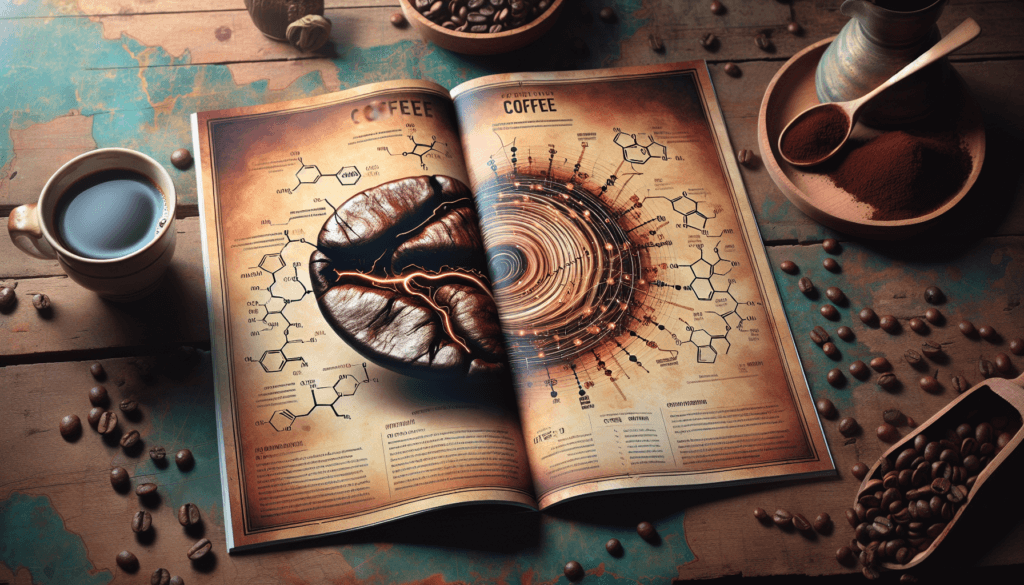Ever wondered what goes into your favorite morning pick-me-up? Coffee, the beloved beverage that kickstarts your day, is actually made from the seeds of a tropical plant called the Coffea. These seeds, commonly referred to as coffee beans, are carefully harvested, roasted, and ground to create the aromatic and invigorating drink that millions of people around the world enjoy. But what exactly is inside those little beans that make your cup of coffee so irresistible? Let’s uncover the mysterious components that make up coffee’s delightful concoction.

Coffee Beans
When you think of coffee, the first thing that comes to mind is probably the delicious, aromatic beverage that helps you start your day. But have you ever wondered what coffee is actually made of? At its core, coffee is made from beans, specifically the seeds of the Coffea plant. There are two main types of coffee beans that are commonly used to make the coffee we enjoy: Arabica and Robusta.
Arabica Beans
Arabica beans are widely regarded as the higher quality choice when it comes to coffee beans. They are grown at higher elevations, which results in beans with a more complex and delicate flavor profile. Arabica beans are known for their slightly sweet and fruity taste, often accompanied by subtle notes of chocolate or nuts. While they are more expensive than Robusta beans, many coffee enthusiasts consider the flavor of Arabica to be worth the extra cost.
Robusta Beans
On the other hand, Robusta beans are known for their robust flavor, as the name suggests. They are grown at lower altitudes and have a higher caffeine content compared to Arabica beans. Robusta beans have a stronger and more bitter taste, with a hint of earthiness. While they may not offer the same complexity as Arabica beans, Robusta beans are commonly used in espresso blends for their crema-enhancing properties and ability to stand up to milk.
Processing Methods
The journey of coffee from bean to cup involves several processing methods that greatly impact the flavor and characteristics of the final brew. Let’s explore the three main processing methods: wet processing, dry processing, and semi-dry processing.
Wet Processing
Wet processing, also known as washed processing, involves removing the outer layers of the coffee cherry through mechanical pulping. The coffee beans are then fermented in water for a specific period of time to remove any remaining pulp and encourage the development of complex flavors. Wet processing is known for producing coffees with bright acidity, cleaner flavors, and a smoother overall cup.
Dry Processing
Dry processing, also known as natural processing, is the oldest and simplest method of processing coffee. After the coffee cherries are harvested, they are dried under the sun or in drying machines with the fruit still intact. The fruit shrinks as it dries, and the beans inside absorb the flavors of the fruit. This method often results in coffees with a full body, fruity and wine-like flavors, and a hint of natural sweetness.
Semi-Dry Processing
Semi-dry processing, also known as pulped natural processing, is a hybrid between wet and dry processing. During this method, the outer skin of the coffee cherry is mechanically removed, but some of the fruit remains on the bean as it is dried. This results in a combination of the vibrant acidity found in wet-processed coffees and the fruity sweetness of dry-processed coffees. Semi-dry processing offers the best of both worlds for those seeking a balanced, flavorful cup.

Roasting
Once the coffee beans have been processed, they are ready to be roasted. Roasting is a crucial step in the coffee production process as it brings out the flavors and aromas locked within the beans. The way coffee beans are roasted greatly impacts the taste of the final cup. Let’s delve into roast levels and the chemical changes that occur during roasting.
Roast Levels
Roasting coffee beans involves subjecting them to high heat, causing them to undergo physical and chemical transformations. There are different levels of roast, each resulting in unique flavors and characteristics:
-
Light roast: Also known as a “Cinnamon” or “City” roast, light roasts preserve the natural flavors of the coffee bean, resulting in a crisp, acidic taste with pronounced brightness.
-
Medium roast: Sometimes referred to as a “City+” or “Full City” roast, medium roasts strike a balance between acidity and body. They offer a slightly sweeter and more balanced cup with more developed flavors.
-
Dark roast: Popular dark roast profiles, such as “French” or “Italian” roasts, result in beans with a smoky, bold flavor. These roasts have a rich body with diminished acidity and prominent bittersweet notes.
-
Extra dark roast: Often called “Spanish” or “Continental” roasts, extra dark roasts produce extremely bold, almost charred flavors. These roasts are characterized by their low acidity and intense bitterness.
Chemical Changes
During the roasting process, numerous chemical reactions occur within the coffee beans. As the beans are exposed to heat, they undergo a series of transformations that not only affect the flavor but also the color and physical structure of the beans. Maillard reactions, for example, contribute to the development of desirable flavors, including caramel and chocolate notes. Additionally, the breakdown of carbohydrates and the release of carbon dioxide are some of the chemical changes that take place during roasting. These chemical reactions are crucial in unlocking the complex flavors and aromas that make coffee so delicious.
Grinding
Once the coffee beans have been roasted to perfection, they are ready to be ground. Grinding the beans just before brewing is essential to ensure the best possible flavor extraction. Different brewing methods require different grind sizes to optimize the extraction process. Let’s explore the three main grind sizes: coarse grind, medium grind, and fine grind.
Coarse Grind
A coarse grind is characterized by its larger particle size, similar to the texture of kosher salt. This grind size is commonly used in methods that require longer brewing times, such as immersion methods like French press or cold brew. The larger particles slow down the extraction process, allowing for a rich and full-bodied cup of coffee.
Medium Grind
A medium grind falls between the coarse and fine grind sizes and is often comparable to granulated sugar. This grind size is suitable for drip-brewing methods like pour-over, as it allows for a balanced extraction. The medium grind provides a well-rounded cup with a good balance of acidity, body, and flavor.
Fine Grind
A fine grind is characterized by its small particle size, similar to that of table salt or powdered sugar. This grind size is commonly used in methods with shorter contact times, such as espresso or Turkish coffee. The fine particles ensure a quick and thorough extraction, resulting in a concentrated, intense cup of coffee.

Brewing Methods
Now that you have freshly ground coffee at hand, it’s time to explore the various brewing methods that can transform those grounds into a delightful cup of joe. Here are four popular brewing methods: drip-brewing, espresso, French press, and cold brew.
Drip-brewing
Drip-brewing, also known as filtered brewing, is one of the most common and accessible methods for brewing coffee. It involves pouring heated water over a bed of coffee grounds and allowing it to pass through a filter. This method produces a clean and clear cup of coffee, with the amount of extraction controllable through variables such as grind size, water temperature, and brew time.
Espresso
Espresso is a concentrated form of coffee that is brewed by forcing hot water through tightly packed finely ground coffee. The high pressure and shorter brewing time result in a strong, full-bodied, and highly aromatic cup of coffee. The hallmark of espresso is its crema, a layer of golden-brown foam that forms on top of the shot.
French Press
The French press, also known as a press pot or plunger pot, is a full-immersion brewing method. Coarsely ground coffee is steeped in hot water for a few minutes, and then a plunger with a metal filter is pressed down to separate the brewed coffee from the grounds. This brewing method offers a rich, full-bodied cup with more oils and sediment compared to filtered brewing.
Cold Brew
Cold brew has gained popularity as a refreshing and smooth alternative to hot coffee. It involves steeping coffee grounds in cold or room temperature water for an extended period, typically 12-24 hours. The slow extraction process produces a concentrated coffee concentrate that can be diluted to taste with water or milk. Cold brew is known for its low acidity and naturally sweeter profile.
Water
While coffee beans play a crucial role in the final cup, the quality of water used for brewing is equally important. Water makes up the majority of the coffee beverage, so its quality greatly affects the taste and overall experience. Let’s discuss the importance of water quality and temperature in coffee brewing.
Quality
Using high-quality water is essential in order to fully appreciate the flavors and nuances present in coffee. Water that is free from impurities, such as excessive minerals or chlorine, allows the true character of the coffee to shine through. Ideally, filtered water or spring water is recommended for brewing coffee, especially if your tap water has a strong taste or odor.
Temperature
The temperature of the water used in brewing can significantly impact the flavor extraction. The optimal temperature for brewing coffee is typically between 195°F and 205°F (90°C and 96°C). Water that is too hot can result in over-extraction, leading to a bitter and unpleasant taste. Conversely, water that is too cool may not extract enough flavor, resulting in a weak and lackluster cup. Achieving the right water temperature is crucial in ensuring a well-balanced and flavorful brew.

Caffeine
Caffeine is one of the most well-known and widely consumed compounds found in coffee. It is a natural stimulant that affects the central nervous system, providing an energy boost and increasing alertness. While caffeine content can vary depending on factors such as the type of bean, roast level, and brewing method, coffee is generally recognized as a significant source of caffeine. Let’s explore the effects of caffeine on the body and the methods used to decaffeinate coffee.
Effects on the Body
Caffeine, when consumed in moderation, can have several beneficial effects on the body. It can enhance cognitive function, improve focus and concentration, and increase physical performance. Caffeine can also provide a temporary energy boost and help alleviate fatigue. However, it is important to consume caffeine in moderation, as excessive intake can lead to side effects such as restlessness, increased heart rate, and disrupted sleep patterns. It is recommended to be mindful of your caffeine consumption and find the balance that works best for you.
Decaffeination Methods
For those who prefer to limit their caffeine intake or are sensitive to its effects, decaffeinated coffee is a popular choice. Decaffeination is the process of removing most of the caffeine from coffee beans, while still preserving the flavor compounds. There are different methods employed to decaffeinate coffee, including the Swiss Water Process, solvent-based methods, and carbon dioxide extraction. Each method has its own advantages and limitations, but the goal remains the same: to provide a delicious cup of coffee with reduced caffeine content.
Flavor Compounds
The complex flavors found in coffee are a result of the numerous compounds present in the beans. This rich diversity of flavor can be attributed to various chemical groups, including acids, phenols, aldehydes, ketones, and esters. Let’s take a closer look at these flavor compounds and how they contribute to the taste and aroma of coffee.
Acids
Acids play a significant role in the overall flavor profile of coffee. They contribute to the brightness and liveliness of the cup, adding a subtle tanginess or acidity. Some common acids found in coffee include citric acid, malic acid, and acetic acid. These acids interact with other flavor compounds to create a balanced and complex taste.
Phenols
Phenols are aromatic compounds that contribute to the distinctive aroma and taste of coffee. They are responsible for the floral, fruity, or nutty notes that you may detect in your cup. Phenolic compounds also possess antioxidant properties and play a role in the potential health benefits associated with coffee consumption.
Aldehydes
Aldehydes are volatile compounds that contribute to the aroma of coffee. They provide various scents, ranging from sweet and fruity to nutty and floral. Aldehydes are formed during the roasting process, adding complexity and depth to the overall flavor profile.
Ketones
Ketones are compounds that contribute to the rich, sweet aromas found in coffee. They can enhance the perception of sweetness, adding depth and roundness to the flavor profile. Ketones are synthesized during the roasting process and are responsible for some of the caramel, toffee, and chocolate notes found in coffee.
Esters
Esters are compounds formed during the fermentation and aging processes, contributing to the fruity and floral aromas in coffee. They play a crucial role in creating the complex, fruit-forward flavors that are often associated with specialty coffees. Coffees with a higher ester content are known for their vibrant and nuanced taste.

Other Components
In addition to flavor compounds, coffee beans also contain other components that can contribute to the overall composition of the beverage. These components include lipids, minerals, and plant fiber.
Lipids
Lipids, or coffee oils, are natural oils found in coffee beans. They are responsible for the oily sheen often seen on the surface of freshly brewed coffee. Lipids contribute to the mouthfeel, richness, and aroma of the cup. While some lipids can enhance the overall experience, excessive amounts can lead to a greasy or unpleasant sensation in the mouth.
Minerals
The mineral content of coffee can vary depending on the soil in which the coffee plants are grown. Coffee beans contain a range of minerals, including potassium, magnesium, and calcium. These minerals can add depth and complexity to the overall flavor of coffee. However, excessive mineral content can also contribute to off-flavors and bitterness in the cup.
Plant Fiber
Coffee beans contain plant fiber, which can contribute to the body and texture of the brewed coffee. The presence of fiber can affect the mouthfeel, creating a more viscous or velvety sensation. Plant fiber also plays a role in the extraction process, as it can help retain flavors and prevent over-extraction.
Health Aspects
Coffee is not only a delightful beverage, but it also offers potential health benefits when consumed in moderation. Let’s explore some of the health aspects associated with coffee consumption, including antioxidant benefits and potential risks.
Antioxidant Benefits
Coffee contains a variety of antioxidants, which are compounds that protect the body from free radicals and oxidative stress. Antioxidants help neutralize harmful molecules and may have a positive impact on overall health. Some studies suggest that regular coffee consumption is associated with a reduced risk of certain diseases, including type 2 diabetes, Parkinson’s disease, and liver disease. However, it is important to note that individual responses to coffee can vary, and more research is needed to fully understand the potential health benefits.
Potential Risks
While coffee can have its benefits, it is also important to be aware of potential risks associated with excessive consumption or individual sensitivities. Caffeine, as mentioned earlier, can cause restlessness, increased heart rate, and disrupted sleep patterns when consumed in excess. Some individuals may also be more sensitive to the effects of caffeine and experience gastrointestinal issues or increased anxiety. Additionally, coffee is a diuretic and can lead to increased urine production, which may be a concern for those with certain medical conditions. It is always best to listen to your body and consume coffee in moderation to avoid any potential risks.
In conclusion, coffee is a complex beverage made from beans that undergo various stages of processing, roasting, grinding, and brewing. Understanding the different types of coffee beans, processing methods, roast levels, grind sizes, brewing methods, water quality, and the chemical compounds present in coffee can greatly enhance your appreciation and enjoyment of this beloved beverage. Remember to savor each sip, experiment with different flavors and techniques, and find the perfect cup of coffee that suits your taste preferences. Cheers to the world of coffee and the endless possibilities it offers!


